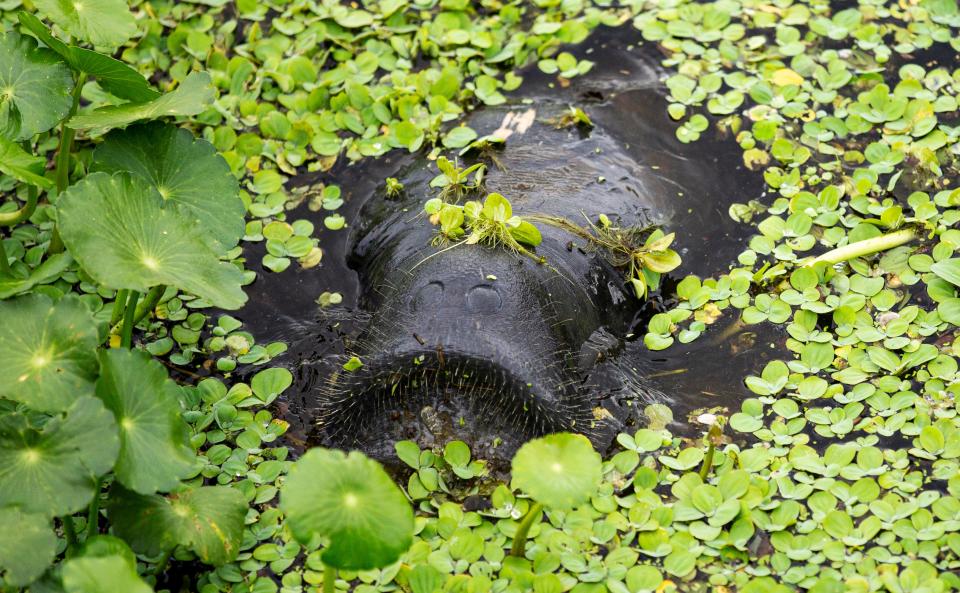Army Corps: Winter lake releases could help avoid algae that's prevalent in warmer months
Large-scale Lake Okeechobee releases are likely a few weeks away as the U.S. Army Corps of Engineers continues to monitor a high lake during an El Nino winter season that's been tainted by heavy rains.
"It's important to be able to accept water into the lake during the summer without the lake getting too high," said Major Cory Bell, second in command at the Army Corps' Jacksonville office. "We must consider higher releases before the onset of the hurricane and rainy seasons."
Bell spoke during a media call Friday held by the Army Corps, which hosts these types of calls every week during summer and early fall, the months with the most rain and tropical systems.

The surface of Lake Okeechobee was at 16.3 feet Friday, which is too deep for the aquatic vegetation in the lake.
Lake vegetation like eel grass is down to just 1 acre, said Clewiston fishing guide and captain Scott Martin.
"We’ve got to take our medicine and take the water out of the lake," Martin said. "There’s no way around it. The lake is going to gain 3 feet of water during the rainy season, and that’s not far away."
Recent flows at the W.P. Franklin Lock and Dam in Alva have hovered around 2,000 cubic feet per second, and that rate is expected to stay steady for a few weeks ― depending on how much rain falls within the Caloosahatchee River's watershed.
Those flows will go higher if the Army Corps decides to release more lake water.
Corps: water will go east, west and south
The surface of the lake has typically been kept between 12.5 feet and 15.5 feet above sea level, which can be a healthy range for aquatic plants in the lake.
But the lake was high for most of 2023, and more El Nino rains could force the Army Corps to ramp up releases.
More: Iconic 10-year-old male panther joins list of Florida's famous big cats
Bell said any releases would be made to the Caloosahatchee and St. Lucie rivers as well as south to Everglades National Park.
The National Oceanic and Atmospheric Administration, or NOAA, is calling for above-average rain across the Sunshine State between now and the rainy season, a trend that could make managing the lake even more difficult.
"EL Nino brings above average amounts (of rainfall), and we take that into the calculus of what releases we're going to make. we continue to look at the forecast," Bell said.
Summer rains are only a few months away
Bell said releasing water before the summer would also help avoid the spread of blue-green algae as outbreaks are less frequent during cooler months.
"Its' very hard to balance the estuaries on the east and west coast and beneficial releases to the south," Bell said. "I think within the next few weeks if it continues to be wet, we're going to have to make releases. But if we make releases, it will be across the board: east, west and south."
More: Reporter finds flamingo haven on recent 11-day Everglades canoe trip
"We're trying to set ourselves up for summer, and it's hard to predict what the weather is going to be like," Bell said.
Newton Cook, with United Waterfowlers – Florida, is a regular critic of the Army Corps, and he says the agency should have started releases months ago.
"They should have been making releases back in December, and that’s why they’re in trouble," Cook said. "And they are in trouble. (South Florida Water Management District engineers) said maybe we'd get it to 13.5 feet, and that’s 3 feet off the lake in three months. They’re not going to get that much water off the lake without releases."
Calusa Waterkeeper Codty Pierce said there should be balance in the Everglades system, which stretches from just south of Orlando to Florida Bay.
"The last week we are in decent flow levels from (Franklin Lock), but I am most thankful for no reported cyanobacteria in the river for this past week," Pierce said. "Still a highlight of data is that we are receiving 77% of lake discharges out our side."
Connect with this reporter: Chad Gillis on Facebook.
This article originally appeared on Fort Myers News-Press: Lake Okeechobee still high, Army Corps expected to start releases soon

